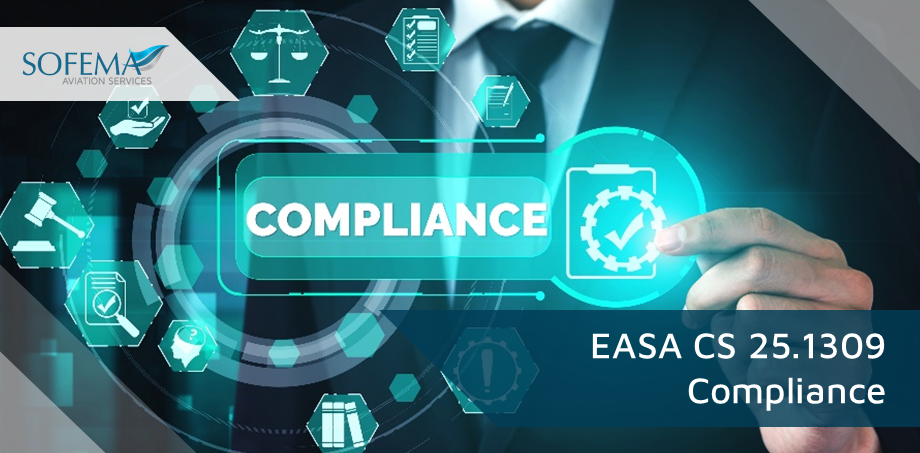Sofema Aviation Services (SAS) ww.sassofia.com considers the requirements to ensure compliance with CS 25.1309
Note: The applicant should obtain early concurrence of the certification authority on the choice of an acceptable means of compliance.
Introduction: Compliance with CS 25.1309(a)
- Equipment covered by CS 25.1309(a)(1) must be shown to function properly when installed.
o The aeroplane operating and environmental conditions over which proper functioning of the equipment, systems, and installation is required to be considered include the full normal envelope of the aeroplane as defined by the Aeroplane Flight Manual operating limitations together with any modification to that envelope associated with abnormal or emergency procedures.
o Other external environmental conditions such as atmospheric turbulence, HIRF, lightning, and precipitation, which the aeroplane is reasonably expected to encounter, should also be considered.
o The severity of the external environmental conditions, which should be considered, are limited to those established by certification standards and precedence.
- In addition to the external operating and environmental conditions, the effect of the environment within the aeroplane should be considered.
o These effects should include:
- Vibration and acceleration loads,
- Variations in fluid pressure and electrical power,
- Fluid or vapour contamination, due either to the normal environment or accidental leaks or spillage and handling by personnel.
Documents referenced define a series of standard environmental test conditions and procedures, which may be used to support compliance.
- RTCA, Inc., Document No. DO-160D/EUROCAE ED-14G, Environmental Conditions and Test Procedures for Airborne Equipment.
- Society of Automotive Engineers (SAE) Aerospace Recommended Practice (ARP) 4754A/EUROCAE ED-79A, Guidelines for development of civil aircraft and systems.
- Society of Automotive Engineers (SAE) Aerospace Recommended Practice (ARP) 4761, Guidelines and Methods for Conducting the Safety Assessment Process on Civil Airborne Systems and Equipment.
Equipment covered by (CS) Technical Standard Orders containing environmental test procedures or equipment qualified to other environmental test standards can be used to support compliance.
- The conditions under which the installed equipment will be operated should be equal to or less severe than the environment for which the equipment is qualified.
- The required substantiation of the proper functioning of equipment, systems, and installations under the operating and environmental conditions approved for the aeroplane may be shown by test and/or analysis or reference to comparable service experience on other aeroplanes.
- It must be shown that the comparable service experience is valid for the proposed installation.
- For the equipment systems and installations covered by CS 25.1309(a)(1), the compliance demonstration should also confirm that the normal functioning of such equipment, systems, and installations does not interfere with the proper functioning of other equipment, systems, or installations covered by CS 25.1309(a)(1).
The equipment, systems, and installations covered by CS 25.1309(a)(2) are typically those associated with amenities for passengers such as passenger entertainment systems, in-flight telephones, etc., whose failure or improper functioning in itself should not affect the safety of the aeroplane.
- Operational and environmental qualification requirements for those equipment, systems, and installations are reduced to the tests that are necessary to show that their normal or abnormal functioning does not adversely affect the proper functioning of the equipment, systems, or installations covered by CS 25.1309(a)(1) and does not otherwise adversely influence the safety of the aeroplane or its occupants.
o Examples of adverse influences are:
- Fire,
- Explosion,
- Exposing passengers to high voltages, etc.
o Normal installation practices should result in sufficiently obvious isolation so that substantiation can be based on a relatively simple qualitative installation evaluation. If the possible impacts, including failure modes or effects, are questionable, or isolation between systems is provided by complex means, more formal structured evaluation methods may be necessary.
Compliance with CS 25.1309(b).
Paragraph 25.1309(b) requires that the aeroplane systems and associated components, considered separately and in relation to other systems, must be designed so that any catastrophic failure condition is extremely improbable and does not result from a single failure.
- It also requires that any hazardous failure condition is extremely remote and that any major failure condition is remote.
- An analysis should always consider the application of the fail-safe design concept and give special attention to ensuring the effective use of design techniques that would prevent single failures or other events from damaging or otherwise adversely affecting more than one redundant system channel or more than one system performing operationally similar functions.
General compliance with the requirements of CS 25.1309(b).
- Should be shown by analysis and, where necessary, by appropriate ground, flight, or simulator tests.
- Failure conditions should be identified and their effects assessed.
- The maximum allowable probability of the occurrence of each failure condition is determined from the failure condition’s effects, and when assessing the probabilities of failure conditions, appropriate analysis considerations should be accounted for.
Any analysis must consider:
- Possible failure conditions and their causes, modes of failure, and damage from sources external to the system.
- The possibility of multiple failures and undetected failures.
- The possibility of requirement, design and implementation errors.
- The effect of reasonably anticipated crew errors after the occurrence of a failure or failure condition.
- The effect of reasonably anticipated errors when performing maintenance actions.
- The crew alerting cues, corrective action required, and the capability of detecting faults.
- The resulting effects on the aeroplane and occupants, considering the stage of flight, the sequence of events/failures occurrence when relevant, and operating and environmental conditions.
Next Steps
Follow this link to our Library to find & download related documents for Free.
Sofema Aviation Services (www.sassofia.com) offers training to cover CS 25 System Safety Assessments – please see the following course.
For additional questions or comments – please email team@sassofia.com
Tags:
Aircraft Flight Manual, aviation, Aviation regulatory training, aviation system safety, Aviation Training, Certification, Compliance, CS 25.1309, EASA, EASA regulations, Regulatory Compliance, Regulatory training, SAS blogs, SAS training, Sofema Aviation Services (SAS)




